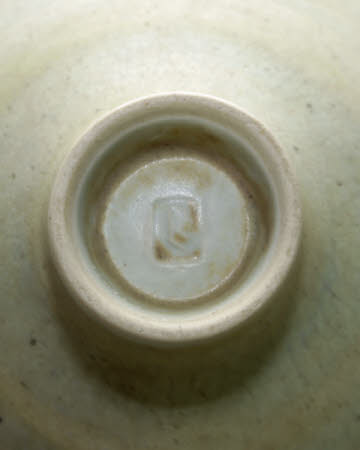Bowl
Lucie Rie (1902-1995)
Category
Ceramics
Date
1972 - 1980
Materials
Glazed porcelain
Measurements
120 mm (H); 194 mm (Dia)
Place of origin
London
Order this imageCollection
Greenway, Devon
NT 118953
Caption
In the early 1950s Lucie Rie wrote: ‘to make pottery is an adventure to me, every new work is a new beginning’. Rie is one of the most important and influential studio potters of the 20th century. She developed a Modernist, minimal aesthetic that caused her work to stand out from that of her contemporaries. Her pots are useful shapes in porcelain and stoneware, thrown on the wheel – particularly bowls, bottles and vases – with a focus on creating distinctive surface effects through subtly layered, textured glazes, or lines of sgraffito incised through dark slips. Rie was born in Vienna and attended the Kunstgewerbeschule – the art school attached to the progressive Wiener Werkstätte (Vienna Workshop). Students were encouraged to experiment with different materials and Rie chose to specialise in pottery – later describing herself as being ‘lost to the wheel’. Working from a studio in her flat, Rie applied her glazes onto the raw clay (most potters do this after an initial biscuit firing), which allowed her to develop the distinctive textured surfaces that characterise her work. Rie’s reputation grew as she sold and exhibited her work internationally, including at the prestigious Milan Triennale in 1936 and the Paris Exposition Internationale the following year, winning medals at both. Rie, who was Jewish, was forced to leave Austria in 1938 to escape the Nazi regime. She settled in London and remained there for the rest of her life, working from a studio in Albion Mews, Paddington. Her Modernist work was very different from the Leach tradition favoured in Britain, so Rie worked hard to re-establish her profile. Before restrictions on the making of non-essential goods were introduced in 1942, Rie made tableware, as well as small pieces of jewellery and ceramic buttons for fashion houses and high-end department stores. After the war, she resumed her work and established a long, highly successful career. Her work is represented in major collections across the world and has been celebrated in many exhibitions, including retrospectives at the Sainsbury Centre, Norwich, and the Victoria and Albert Museum, London, in 1981. Among her many accolades, in 1991 she was the first potter to be awarded the honour of Dame Commander of the British Empire.
Summary
Bowl, porcelain, tall cylindrical foot with slightly everted sides, Lucie Rie, London, ca 1972-80; decorated with pale green and brown glazes.
Provenance
Introduced to the Property by Anthony Hicks
Marks and inscriptions
Base: ‘LR’ mark
Makers and roles
Lucie Rie (1902-1995), potter
References
Conroy, Rachel, Women Artists and Designers at the National Trust, 2025, pp. 244-247


